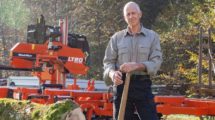1. Legal framework
Timber transport in Romania is mainly regulated by the following legislation:
- Forestry Code (Law 46/2008)
- HG 497/2020 - Rules on the origin, movement and marketing of timber materials, amended and supplemented by GD 512/2022
- Law 171/2010 on the establishment and sanctioning of forest offences
The role of SUMAL 2.0
SUMAL 2.0 (Integrated Information System for the Tracking of Timber Material) is the electronic tool for ensuring the traceability of timber.
The use of SUMAL is mandatory for:
- forestry scouts
- economic operators storing, processing, sorting, marketing timber
- professional transporters (over 20 m3/year)
- timber exporters/importers
- forestry control authorities
The application has dedicated modules for planning, approvals, control, reporting, etc. Its purpose is to provide a clear record of the origin and movement of timber.
3. Documents of provenance
In order to be legally transported, the timber must be documented:
- APV (act of value addition) for timber from authorised parts,
- Electronic register (SUMAL 2.0 Agent) for timber in warehouses,
- Accompanying notice for the timber being transported,
- Customs import declaration (DVI) or FLEGT licence for timber imported from third countries,
- Intra-Community documents (invoice, CMR, etc.) for timber imported from the EU,
- Various minutes of surrender, inventory, seizure for other specific situations.
4. Accompanying notice
The accompanying notice is the document issued in SUMAL 2.0 that must accompany any shipment of timber. It can be:
- electronically on the professional carrier's device
- PDF/printed, when the carrier is not professional
- letric, in some cases (max 20 cubic metres from the place of harvest)
Types of opinions:
- from the place of harvest
- from storage/temporary storage
- for imported timber
- for transhipment
- for purchases (wood bought from individuals)
- for technological transport
Issuers of opinions can be:
- economic operators legally harvesting timber
- warehouses that trade wood
- forestry offices (in situations specified in the rules)
When the opinion is issued, data on:
- issuer,
- loading point,
- the recipient and the unloading point,
- means of transport,
- timber transported (species, species, volumes).
5. Obligations of the carrier
Professional drivers have specific obligations during transport:
- take 4 photos of the load (front, rear, side),
- keep the data connection and GPS receiver on,
- update its position regularly,
- report any incidents or malfunctions.
At destination, the recipient accepts or rejects the goods in the application. If he refuses, the issuer of the notice must request a new notice to return the goods.
In the case of non-professional consignments (max 20mc), the letter of advice shall be handed over to the consignee as proof of origin.
6. Wood without legal provenance
Timber transported without a valid permit is considered to be of illegal origin and is confiscated. Other situations in which transported timber is confiscated:
- expired notice
- transport without authorisation
- opinion without a corresponding opinion in SUMAL
- volume greater than in the opinion (over tolerances)
- transport of timber not included in the notice
- transport with loading/unloading point different from the notice
Penalties for illegal transport are set by Law 171/2010 and include fines and confiscation.
7. Volume of timber transported
- The volume can be determined by individual cutting (thick wood), measuring in figures (thin wood, firewood) or weighing (for lumber, chipping). The methods and tolerances are laid down in the standards.
- The accompanying document must include the volume data. For thick round wood (>24cm) the number of pieces, length and diameter of each piece must be entered. For thin wood, the number of geometric figures and their dimensions must be entered. Non-timber can be cubed into figures.
8. Felling and clearing
- The clearing of fruit trees and shrubs (over certain areas) or the felling of edible nuts and chestnuts can only be done with a permit from the county agricultural directorates.
- The authorisation is issued on the basis of documentation showing the decline/ageing of the plantation, disease infestation or its location in an area where construction of local/national interest is to follow.
- Cutting/trimming without authorisation is punishable by a fine.
9. Further information
- For case-by-case interpretations or complex cases, professionals should refer to legal texts or specialist advice.
- SUMAL 2.0 has a helpdesk module where you can ask questions. Forestry offices and directorates also provide information and support.
- In view of the damage caused by illegal logging, professionals must pay the utmost attention to compliance with forestry rules. Compliance with the legal framework brings long-term benefits to both the environment and the timber processing industry.
I hope this article provides a useful overview of the timber transport regulations in Romania. For updates and further details, please check the official websites of the forestry authorities regularly.































Add comment